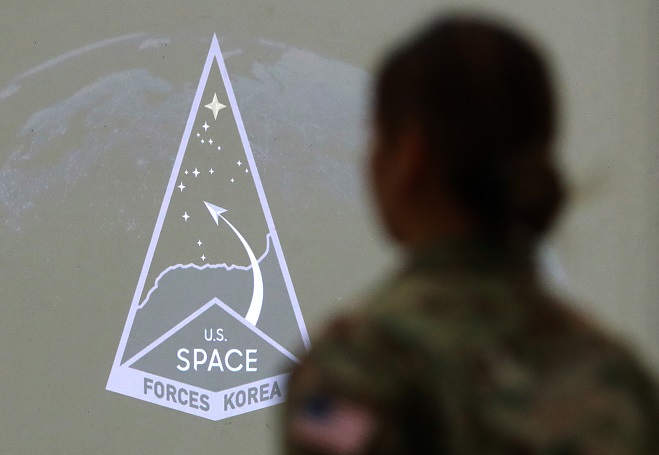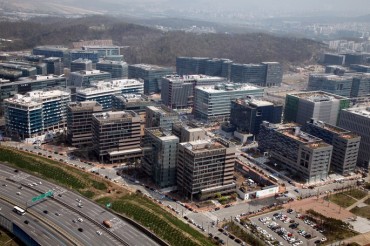
This file photo, taken Dec. 14, 2022, shows the emblem of the U.S. Space Forces Korea during the unit’s activation ceremony at Osan Air Base in Pyeongtaek, 60 kilometers south of Seoul. (Pool photo) (Yonhap)
PYEONGTAEK, Aug. 31 (Korea Bizwire) — The U.S. Space Force unit in South Korea seeks to step up cooperation with the South Korean military to strengthen readiness against North Korean missile threats, its officials have said, amid Pyongyang’s continued saber-rattling.
Since its launch last year, U.S. Space Forces Korea has been working with other U.S. military branches here and the South Korean military to provide space-based capabilities, such as a missile early warning system, to better deal with North Korean threats, recently highlighted by its launch of two short-range ballistic missiles Wednesday night.
“We have an adversarial presence north of us, so it is upon us to provide that expertise,” Maj. Matt Taylor, deputy commander of the U.S. Space Forces Korea, told reporters Wednesday at Osan Air Base in Pyeongtaek, 60 kilometers south of Seoul.
“It’s getting the indications (on the missile) out to all counterparts — ROK, U.S. and the various command posts throughout the peninsula … and tracking where it’s going,” he said.
ROK stands for the Republic of Korea, South Korea’s official name.
Lt. Col. Kim Jong-ha, commander of the South Korean Air Force’s Space Operations Squadron, explained that satellites are the fastest way to respond to missile warnings, and the U.S. unit serves to first detect and provide such information by using its assets.
South Korea currently does not possess military spy satellites, although it seeks to launch its first one in November.
As part of efforts to sharpen readiness, the U.S. unit is currently taking part in the annual South Korea-U.S. Ulchi Freedom Shield exercise for the first time. The drills are set to end later Thursday after kicking off Aug. 21.
“This is by far the largest stride taken historically to combine the ROK and the U.S.,” Taylor said, although he did not elaborate on the training due to operational security.
The allies’ cooperation against North Korean missiles is also set to expand, as President Yoon Suk Yeol, U.S. President Joe Biden and Japanese Prime Minister Fumio Kishida reaffirmed efforts to operationalize a system to share North Korean missile warning data in real time by the end of this year during their Camp David summit on Aug. 18.
“My understanding is there are future bilateral agreements and possibly trilateral agreements that are in the works, especially with the missile warning,” Taylor said, although he noted that none of the details have been decided.
The U.S. military has not established a separate Space Force unit in Japan, but Msg. Shawn Stafford of U.S. Space Forces Korea said it should be set up there “shortly.”
“We do plan on integrating further with our counterparts in Japan, as well as in Hawaii, to make sure that we’re giving the best possible picture to our alliance,” Stafford said, referring to the U.S. Space Forces Indo-Pacific in the U.S. state.
(Yonhap)






